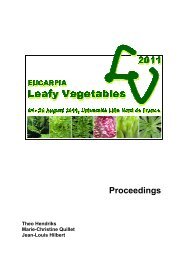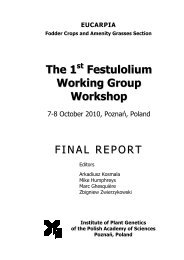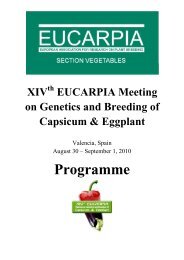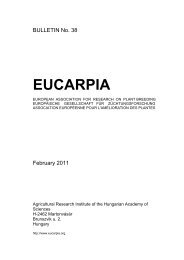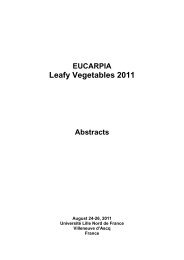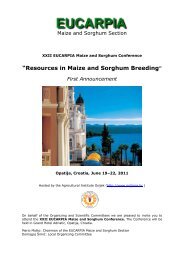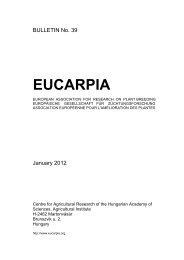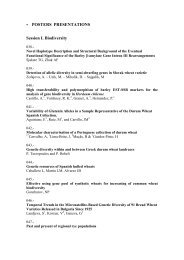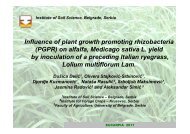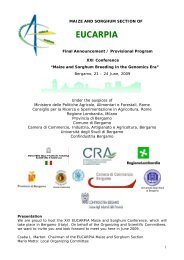Plant breeding for organic and sustainable, low-input agriculture
Plant breeding for organic and sustainable, low-input agriculture
Plant breeding for organic and sustainable, low-input agriculture
Create successful ePaper yourself
Turn your PDF publications into a flip-book with our unique Google optimized e-Paper software.
Do varieties rank differently in <strong>organic</strong> <strong>and</strong> conventional systems?<br />
M. Przystalski 1 , E. Thiemt 2 , B. Roll<strong>and</strong> 3 , L. Ericson 4 , A. Osman 5 , H. Østergård 6 , L. Levy 7 , M.<br />
Wolfe 8 , A. Büchse 9 , H.-P. Piepho 9 , P. Krajewski 1<br />
1 Institute of <strong>Plant</strong> Genetics PAS, Poznań, Pol<strong>and</strong>; 2 State <strong>Plant</strong> Breeding Institute, University<br />
of Hohenheim, Germany; 3 INRA, Rennes, France; 4 SLU, Umeå, Sweden; 5 Louis Bolk<br />
Instituut, Driebergen, The Netherl<strong>and</strong>s; 6 Risø National Laboratory, Denmark; 7 Agroscope<br />
Changins-Waedenswil, Switzerl<strong>and</strong>; 8 The Organic Research Centre Elm Farm, UK;<br />
9 University of Hohenheim, Department of Bioin<strong>for</strong>matics, Stuttgart, Germany<br />
Recently, interest has increased in plant varieties specifically adapted to <strong>organic</strong> farming<br />
conditions. The aim of this study was to answer the question if varieties rank differently in<br />
<strong>organic</strong> <strong>and</strong> conventional systems <strong>and</strong> if separate <strong>organic</strong> trials are needed. The problem was<br />
approached by a comprehensive analysis of several data sets using a common statistical model<br />
involving parameters related to decisions concerning planning of the trials.<br />
The data come from experiments per<strong>for</strong>med in two systems in several environments (years or<br />
sites) in Danmark, the Netherl<strong>and</strong>s, France, Germany, Sweden, Switzerl<strong>and</strong> <strong>and</strong> U.K., with<br />
wheat, barley <strong>and</strong> Triticale varieties. Measurements of yield, height, thous<strong>and</strong> grain weight,<br />
hectoliter weight, protein content, soil coverage, lodging, breaking of straw, <strong>and</strong> infection by<br />
septoria <strong>and</strong> brown rust were taken into account. The analysis was done using a mixed models<br />
methodology al<strong>low</strong>ing to estimate genetic variance <strong>and</strong> genetic covariance. Estimates of the<br />
genetic correlation between <strong>organic</strong> <strong>and</strong> conventional trials were interpreted in terms of<br />
ranking agreement. An approach based on index selection was used to study the effect of the<br />
number of <strong>organic</strong> trials on the response to selection.<br />
Trait means in the <strong>organic</strong> system were <strong>low</strong>er than in conventional trials. Environments had a<br />
large influence on the level of the traits. System x environment interaction was significant in<br />
most cases. The genetic correlation between systems <strong>for</strong> yield <strong>and</strong> height was between 0.79<br />
<strong>and</strong> 1. For lodging <strong>and</strong> septoria it was from 0.80 to 0.90. For other traits the genetic<br />
correlation usually was close to 1. It was found that <strong>for</strong> the genetic correlation of 0.90 the<br />
probability of ranking agreement in the top 10% of varieties is about 0.65. The gain from<br />
adding <strong>organic</strong> trials was found to depend on the relation between the values of the genetic<br />
<strong>and</strong> non-genetic variance components; the functional <strong>for</strong>m of this dependence was given.<br />
The genetic correlation between the <strong>organic</strong> <strong>and</strong> conventional system was found to be high in<br />
most cases. Results presented in this paper provide a way to interpret this correlation in terms<br />
of the agreement of ranking of varieties <strong>and</strong> in terms of the gain of in<strong>for</strong>mation rovided by<br />
<strong>organic</strong> trials. Such interpretation can be helpful to the experimenters in making decisions<br />
about the future series of trials.<br />
Acknowledgement: The work was partially supported by COST Action 860 SUSVAR within<br />
WG 2 Biostatistics <strong>and</strong> WG6 Variety Testing <strong>and</strong> Certification; the work of M. Przystalski was<br />
additionally supported by the grant SPB/COST/KN/DWM 74/2005-2008 from the Polish<br />
Ministry of Science <strong>and</strong> Higher Education.<br />
8




